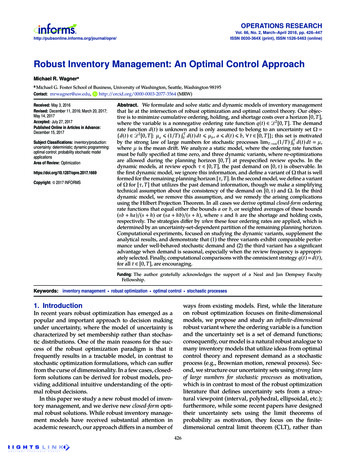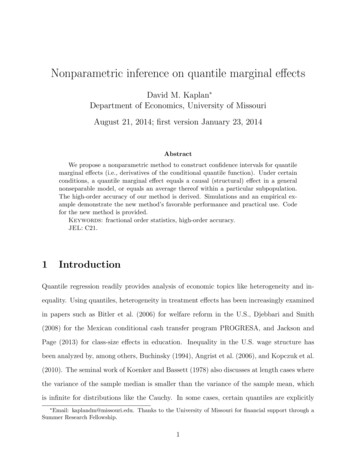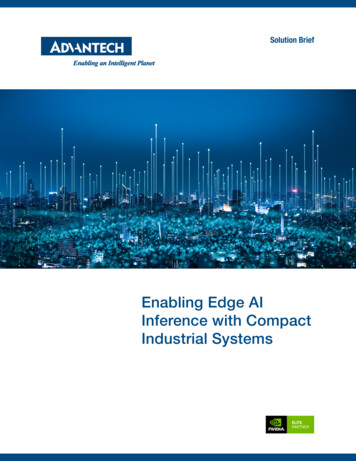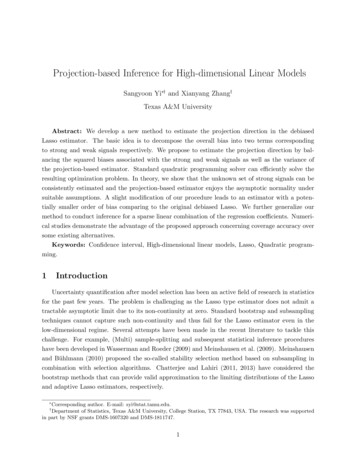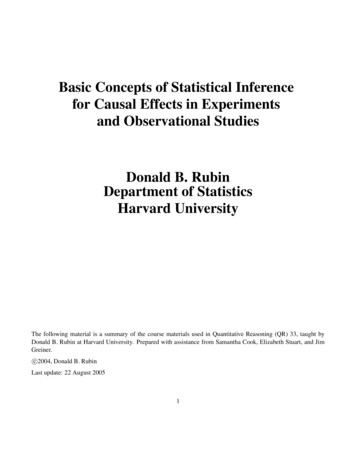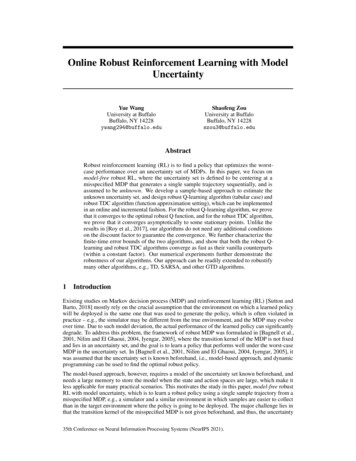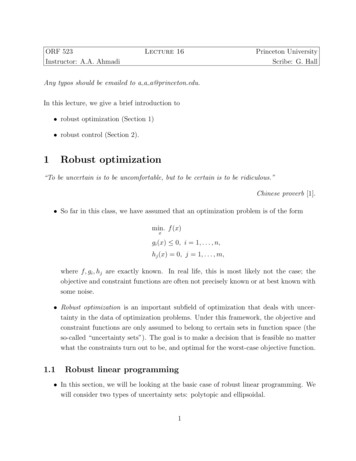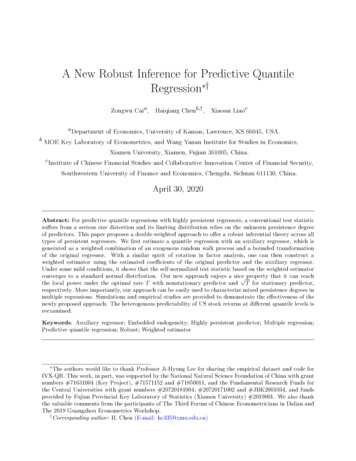
Transcription
A New Robust Inference for Predictive QuantileRegression †Zongwu Caia , Haiqiang Chenb,† , Xiaosai Liaoca Department of Economics, University of Kansas, Lawrence, KS 66045, USA.b MOE Key Laboratory of Econometrics, and Wang Yanan Institute for Studies in Economics,Xiamen University, Xiamen, Fujian 361005, China.c Institute of Chinese Financial Studies and Collaborative Innovation Center of Financial Security,Southwestern University of Finance and Economics, Chengdu, Sichuan 611130, China.April 30, 2020Abstract: For predictive quantile regressions with highly persistent regressors, a conventional test statisticsuffers from a serious size distortion and its limiting distribution relies on the unknown persistence degreeof predictors. This paper proposes a double-weighted approach to offer a robust inferential theory across alltypes of persistent regressors. We first estimate a quantile regression with an auxiliary regressor, which isgenerated as a weighted combination of an exogenous random walk process and a bounded transformationof the original regressor. With a similar spirit of rotation in factor analysis, one can then construct aweighted estimator using the estimated coefficients of the original predictor and the auxiliary regressor.Under some mild conditions, it shows that the self-normalized test statistic based on the weighted estimatorconverges to a standard normal distribution. Our new approach enjoys a nice property that it can reachthe local power under the optimal rate T with nonstationary predictor and T for stationary predictor,respectively. More importantly, our approach can be easily used to characterize mixed persistence degrees inmultiple regressions. Simulations and empirical studies are provided to demonstrate the effectiveness of thenewly proposed approach. The heterogenous predictability of US stock returns at different quantile levels isreexamined.Keywords: Auxiliary regressor; Embedded endogeneity; Highly persistent predictor; Multiple regression;Predictive quantile regression; Robust; Weighted estimator The authors would like to thank Professor Ji-Hyung Lee for sharing the empirical dataset and code forIVX-QR. This work, in part, was supported by the National Natural Science Foundation of China with grantnumbers #71631004 (Key Project), #71571152 and #71850011, and the Fundamental Research Funds forthe Central Universities with grant numbers #20720181004, #20720171002 and #JBK2001034, and fundsprovided by Fujian Provincial Key Laboratory of Statistics (Xiamen University) #2019001. We also thankthe valuable comments from the participants of The Third Forum of Chinese Econometricians in Dalian andThe 2019 Guangzhou Econometrics Workshop.†Corresponding author: H. Chen (E-mail: hc335@xmu.edu.cn)
1IntroductionA long-term issue in financial statistics is to test whether or not a return process (say, asset return orhousing price return) is predictable by a set of lagged predictors (say, financial ratios or/and macroeconomicvariables). The typical method in previous studies is an ordinary least squares (OLS) approach, which isapplied to mean regressions, while conventional test statistics are used to test the significance of coefficients.The conclusions are mixed despite an enormous amount of efforts devoted to this problem in the literature;see, for example, the papers by Ang and Bekaert (2007), Campbell and Thompson (2008), Welch andGoyal (2008), Rapach, Strauss and Zhou (2010), Sekkel (2011), and the references therein. The indefiniteconclusions are partially due to the statistical issues caused by those highly persistent regressors whereconventional test statistics are invalid with a serious size distortion. The problem is more serious if theinnovation in the predictor is highly correlated with the innovation in dependent variable, which is the socalled embedded endogeneity, as studied by Campbell and Yogo (2006), Torous, Valkanov and Yan (2004),Zhu, Cai and Peng (2014), Yang, Long, Peng and Cai (2019), and among others.1 Another explanation is thatthe predictability of asset returns might be heterogenous, relying on economic environment. For example, astronger prediction power is usually found in recession periods for stock markets; see Gonzalo and Pitarakis(2012), which implies potentially greater predictability at lower quantiles. Because mean regressions reflectthe average predictability over all quantiles, they may fail to find evidence for the predictability of assetreturns at some quantiles, particularly in tails. That has motivated researchers to examine the predictabilityof asset returns using quantile regressions, which reveal more information about the predicability under theentire underlying conditional distribution; see, for example, the papers by Koenker (2005) and Xiao (2009)for details.Testing the predictability in a quantile setting is of importance in economics and statistics and alsoof practical attractiveness. First, from economic perspective, empirical evidences have documented that investors’ interest in asset returns is beyond their mean and variance. For example, Harvey and Siddique (2000)and Dittmar (2002) found that the higher order moments are helpful to explain cross-sectional variation inUS stock returns, whereas Cenesizoglu and Timmermann (2008) concluded that the entire distribution of1In the framework of mean regressions, several solutions were proposed in literature, such as the Bonferroni’s method by Campbell and Yogo (2006), the conditional likelihood method by Jansson and Moreira(2006), the linear projection method by Cai and Wang (2014), the instrumental variable (IVX) approach byMagdalinos and Phillips (2009), Kostakis, Magdalinos and Stamatogiannis (2015), Phillips and Lee (2016),and Yang et al. (2019), the weighted empirical likelihood approach by Zhu, Cai and Peng (2014), Liu, Yang,Cai and Peng (2019), and Yang, Liu, Peng and Cai (2018), and the variable addition (VA) or augmentedregression or control function approach by Elliott (2011) and Breitung and Demetrescu (2015) and Yang etal.(2018).1
future stock returns is informative for investment decisions of risk averse investors. Second, from the statistical point of view, quantile regressions are more suitable when the distribution is skewed and/or heavytailed, which is a stylized fact in financial statistics, and consequently the quantile regression technique hasbeen applied widely in risk management operations. For example, the Value at Risk is defined by the unconditional/conditional quantile and is widely used to measure the tail risk in practice. Finally, predictivequantile regressions avoid the order-imbalance issue, a well known theoretical challenge that arises for meanregressions where the dependent variable commonly behaves as martingale differences, while the regressors,fundamental variables, are highly persistent as argued in Phillips (2015).Modeling predictive quantiles and examining their predictability with possible nonstationary regressorsis not a trivial task. The main challenging statistical issues in mean regressions causing the failure of traditionally statistical inferences of the predictive regression still exist for predictive quantile regressions. Tothe best of our knowledge, the papers by Lee (2016) and Fan and Lee (2019) were the first to investigate theasymptotic theory for predictive quantile regressions with both various degrees of persistency and embeddedendogeneity. Indeed, Lee (2016) extended the exogenous instrumental variable approach filtering methodology by Magdalinos and Phillips (2009), Kostakis et al.(2015) for mean regressions to quantile regression,termed as IVX-QR approach. Further, Lee (2016) obtained the asymptotic distribution of test statistics thatare robust to the degree of persistency under the null hypothesis, which can be applied to the multiple predictors case. Recently, Fan and Lee (2019) extended the IVX-QR method in Lee (2016) to the situation withconditionally heteroskedastic errors. However, the IVX-QR requires that the instrumental variable shouldbe less persistent than the predictors. Thus, it might lose some of its test power as illustrated in Kostakis etal. (2015). Meanwhile, the performance of the test is sensitive to the choice of turning parameters involvedin the construction of mildly integrated instrumental variables, and it is difficult to extend to the case withmixed persistent regressors, including both stationary and nonstationary predictors.The main contribution of this paper is to propose a novel approach, termed as double weighted method,to develop a uniform inferential theory for predictive quantile regressions with highly persistent variables.Our method is based on a quantile regression with an auxiliary regressor, which is generated as a weightedcombination of an exogenous simulated nonstationary process and a bounded transformation of the originalregressor. The weight is well-selected through a data-driven approach, such that the auxiliary regressorenjoys having the same persistency degree with the original predictor. Using the coefficients of both originalregressor and auxiliary regressor, with a similar idea of rotation, we construct a weighted estimator betweenthem to eliminate the impact of the embedded endogeneity. Under some mild conditions, it shows thatthe self-normalized test statistics based on the weighted estimator converge to a standard normal or χ2 -2
distribution. Comparing to the IVX-QR approach, our method does not require a less persistent instrumentalvariable, and it could reach the local power under the optimal convergence rate T with nonstationary predictors and T with stationary predictors, respectively. More importantly, our method can easily begeneralized to multiple regressors with mixed persistence degrees and this generalization is seminal in theliterature. Simulations are conducted to demonstrate the effectiveness of our newly proposed approach. Formost cases, our method has better size control and power performance in a finite sample compared overIVX-QR method.Indeed, our motivation for this study is to implement the newly proposed approach for re-examining thepredictability of US stock market returns using eight popular financial ratios and macroeconomic indictors.For the convenience of comparison, the same data set used by Lee (2016) is taken with the sample periodfrom 1927 to 2005. To view whether there is any change after the 2008 global crisis, the data set is updated toDecember of 2018. The main empirical findings can be summarized as follows. First, the predictability for themiddle quantile levels is weaker than both lower and upper quantiles, which is consistent with the previousfindings. Second, in the multivariate prediction quantile regression, many variables lose their predictionpower after controlling other variables. Third, after the World War II, we do not find much evidence ofthe prediction power for some well-known financial ratios, such as earnings to price (d/p) ratio, dividendto price (d/p) ratio and book to market (b/m) ratio. However, the macroeconomic indicators, like T-billrate (tbl), default yield spread (dfy), term spread (tms), show some strong evidence of significant predictionpower, especially at lower and upper quantile levels. The detailed result of this empirical study is reportedin Section 6.Our paper is closely related to the literature of predictive regression with highly persistent regressors.Acknowledging the fact that the asymptotic distribution relies on the time series properties of the regressorsand errors, a series of research papers have aimed to developing a uniform inference theory on predictive meanregressions in the sense that the testing procedure for testing predictability is robust to different persistencecategories, including, but not limited to, the papers by Campbell and Yogo (2006), Magdalinos and Phillips(2009), Chen and Deo (2009), Chen, Deo and Yi (2013), Phillips and Lee (2013), Zhu et al. (2014), Kostakiset al. (2015), Phillips and Lee (2016), Yang et al. (2018), Yang et al. (2019), and Liu et al. (2019), whichfocused on predictive mean regression models.Also, in some way, our paper is tied to the regression with auxiliary variables. Indeed, Toda andYamamoto (1995), and Dolado and Lütkepohl (1996) first proposed a robust testing strategy irrespective ofthe persistency type of regressor through a regression with additional (redundant) variables, such that thecoefficients to be tested are attached to stationary variables, whereas Bauer and Maynard (2012) considered3
the variable addition approach in the context of vector autoregressive processes with unknown persistence.In particular, Breitung and Demetrescu (2015) argued that the traditional VA approaches suffer from a lossof power and generalized VA approach by using instrumental variables that are constructed exogenouslyor endogenously. Different from Breitung and Demetrescu (2015), our paper particularly constructs theadditional regressor in its own way and proposes a new test statistic.The rest of this paper is organized as follows. Section 2 introduces the model framework and Section3 provides the procedures to estimate parameters and to construct the test statistics and also presentsthe asymptotic theories for the proposed estimators and the test statistics. An extension to the multipleregressors with mixed persistence degrees is discussed in Section 4. Section 5 reports the Monte Carlosimulation results. Section 6 presents the analysis results for the empirical applications. Finally, Section 7concludes the paper. The detailed proofs of the main results are given in Appendix.Throughout this paper, the standard notations , and are used to represent weak convergencedpand convergence in distribution as well as convergence in probability, respectively. All limits are for T in all theories, and Op (1) is stochastically asymptotically bounded while op (1) is asymptotically negligible.2Model FrameworkAssume that yt is a dependent variable and its τ th quantile is Qyt (τ Ft 1 ), defined by P (yt Qyt (τ Ft 1 ) Ft 1 ) τ , where Ft 1 is the information set available at time t 1. For simplicity, a linear2 predictive quantile regression is given byQyt (τ Ft 1 ) Qyt (τ xt 1 ) µτ βτ xt 1 ,(2.1)where xt 1 is a predictor to be the presentative (proxy) of Ft 1 , such as dividend-price ratio, earnings-priceratio or macroeconomic variable and so on, which is a time series, commonly modeled by an autoregressive(AR) model asxt ρxt 1 vt , ρ 1 c T α , 1 t T,(2.2) where α 0 or 1 and x0 op ( T ). Of course, a higher order AR model can be considered for xt in (2.2).For simplicity of exposition, we begin with the univariate predictive quantile regression to illustrate the mainidea in this paper. For xt , the following typical types of persistency with different values of c and α areconsidered in the literature:(I0) stationary: α 0 and 1 c 1;2Of course, it would be interesting to investigate a nonlinear predictive quantile regression and it wouldbe a future research topic.4
(NI1) local to unit root: α 1 and c 0;(I1) unit root: c 0;(LE) local to unity on the explosive side: α 1 and c 0.Of course, it is interesting to consider the other cases as 0 α 1, corresponding to the so-called mildlyintegrated processes (c 0) or mildly explosive processes (c 0). The latter can be used to explore themild economic or financial bubbles and other applications, see Phillips, Shi and Yu (2015) and the referencestherein.3 Here, following Lee (2016), a general weakly dependent innovation structure of the linear processon {vt } in (2.2) is imposed and listed below.Assumption 2.1. Assume that vt follows a linear process given by vt Fxj εt j ,j 0where εt is a martingale difference sequence with E(εt Ft 1 ) 0 and var(εt ε t Ft 1 ) Σε for Σε 0 andE εt 2 ν for some ν 0. Here, Fx0 IK , K is the dimension of xt and j 0 j Fxj and jFx (1) j 0 Fxj 0, where Fx (z) j 0 Fxj z . The variance matrix of vt can be expressed as Ωvv ) Fx (1)Σε Fx (1) . h E(vt vt h Remark 2.1. Assumptions 2.1 allows for linear process dependence for vt and imposes a conditionallyhomoskedastic martingale difference sequence (mds) condition for εt . Different from Lee (2016), here wedo not specify a linear predictive mean regression model and hence avoid to impose any assumption on theinnovation for the mean regression model. Note that, for the univariate case, K 1.Define utτ yt Qyt (τ Ft 1 ), which is commonly called the quantile measurement error, similar to themeasurement error in the predictive mean regression model, and also, ψτ (utτ ) τ 1(utτ 0). Now, it iseasy to verify that P (utτ 0 Ft 1 ) τ , E(ψτ (utτ ) Ft 1 ) 0, E(ψτ2 (utτ ) Ft 1 ) τ (1 τ ) and E[ψτ (utτ )4 ] 3τ 4 6τ 3 4τ 2 τ . One may refer to Appendix for the details of proof. Further, define Σψτ v E[ψτ (utτ )vt h ] Fx (1)E[ψτ (utτ )εt ].h By Lemma A.2 in Appendix, one can show easily that Σψτ v . Then, similar to Lee (2016), the functionalcentral limit theorem (FCLT) for {ψτ (utτ ), vt } holds31 ⌊rT ⌋ ψ (u )B (r)τ (1 τ ) Σψτ v τ tτ ψτ BM ,vtBv (r)Σψ τ vΩvvT t 1(2.3)Our methods can be extended to allow for these two cases with some adjustment. To make the proofeasy to follow, our focus is on the simple setting.5
where [Bψτ (r), Bv (r)] is a vector of Brownian motions. Furthermore, the local to unity limit law implies rthat x⌊rT ⌋ T Jxc (r), where Jxc (r) 0 e(r s)c dBv (s) with NI1, I1 and LE predictor; see Phillips (1987)for details.Define λτ,t Corr(ψτ (utτ ), vt ) and assume that λτ,t λτ for simplicity. Then, similar to Campbelland Yogo (2006) for the predictive mean regression model, Lee (2016) seminally showed that the conventional t test statistic tβ̂τ of the predictive quantile regression with nonstationary predictor has the followingasymptotic behaviortβ̂τ 1 λ2τ Z λτ J xc (r)dBx (r) Ωvv J xc (r)2 dr,where Z represents the standard normal distributions. Clearly, λτ measures the degree for the so-calledembedded endogeneity as in Campbell and Yogo (2006) for the predictive mean regression model. Therefore,the conventional test statistics in predictive quantile regression with the NI1, I1 and LE predictor xt areinvalid if λτ 0. Moreover, it is almost impossible to distinguish the difference between I0 and NI1, and/orbetween NI1 and I1, and so on; see also Fan and Lee (2019) for more details, because it is extremelychallenging to estimate consistently the nuisance parameter c and to test if the persistence α equals zero ornot or 0 α 1. Thus, it is necessary to develop a unified inference method to avoid the mistake of makinga false judgement about the persistence of predictors under a quantile framework.Next, some regular assumptions on the conditional density of utτ are imposed, similar to Xiao (2009)and Lee (2016).Assumption 2.2. (i)The sequence of conditional stationary probability density functions {futτ ,t 1 ( )} of{utτ } given Ft 1 evaluated at zero satisfies a moment condition with a non-degenerate mean fuτ (0) E(futτ ,t 1 (0)) 0 and E(fuϑtτ ,t 1 (0)) for some ϑ 1.(ii) For each t and τ (0, 1), fu tτ ,t 1 (x) is bounded with probability one around zero, i.e.,fu tτ ,t 1 ( ) andfutτ ,t 1 ( ) almost surely for all η for some η 0.Remark 2.2. As shown by Xiao (2009), the above conditions in Assumption 2.2 are quite standard and notrestrictive. In particular, the part (i) in Assumption 2.2 is not as restrictive as the counterpart assumptionin Lee (2016), which assumes that futτ ,t 1 (0) follows the FCLT.33.1Statistical Modeling ProceduresEstimation ApproachMotivated by the variable addition approach of predictive mean regression studied by Elliott (2011)and Breitung and Demetrescu (2015), the following new approach is proposed for the predictive quantile6
regression. That is, (2.1) is re-written as follows:Qyt (τ xt 1 ) µτ βτ xt 1 µτ βτ x t 1 γτ zt 1 ,(3.1)where x t 1 xt 1 zt 1 and zt 1 is an additional (auxiliary) variable which is chosen in Section 3.2 in detail.Note that γτ βτ in (3.1), which will be used to construct weighted combined estimator for βτ later. Clearly,µτ , βτ and γτ in (3.1) can be estimated by running the following quantile regression θ̂τ µ̂τ , β̂τ , γ̂τ argTmin ρτ (yt µτ βτ x t 1 γτ zt 1 ) ,µτ ,βτ ,γτ t 2where ρτ (u) u[τ 1(u 0)] is the so-called check function in the statistics literature. Note that Breitungand Demetrescu (2015) only used γ̂τ , the estimator of the coefficient of the auxiliary variable zt , to constructthe test statistic in the predictive mean regression, and required zt to be an instrumental variable (IV) lesspersistent than xt or an exogenous deterministic or stochastic trend process, in order to guarantee thatthe asymptotic distribution of the test statistic is irrelevant to the nuisance parameter c. However, if zt isgenerated as an IV less persistent than xt , the corresponding test statistic suffers from the loss of power forthe case with nonstationary xt , while if zt is generated as an exogenous deterministic or stochastic trendprocess, the test is invalid for the case with stationary xt .To avoid this problem, the variable addition approach is improved in the following two aspects. First,a combined approach is used to construct the appropriate additional variable zt , such that its persistenceis always the same as that for the predictor xt while its key component is independent of xt for NI1, I1and LE cases. Second, a weighted combined estimator is proposed by using the coefficients of x t 1 and theadditional variable zt . With these two improvements, one can show that the test statistic based on theweighted estimator, after constructed by self-normalization to eliminate the nuisance parameter c, can avoidnot only the size distortion but also the loss of power with arbitrary persistence.Next, it turns to the discussion on how to construct the weighted estimator for given zt and then,elaborating the choice of zt which will be presented in Section 3.2. As mentioned earlier, γτ βτ so that itshould be better to combine β̂τ and γ̂τ together to obtain a weighted estimation for βτ . Consequently, therotation idea in the principle component analysis is applied here to construct the estimator for βτ , which isthe weighted sum of β̂τ and γ̂τ , denoted by β̂τw ,β̂τw W1W2β̂τ γ̂τ ,W1 W2W1 W2(3.2)where W1 and W2 are two weighting functions. By selecting some appropriate weights W1 and W2 , one canconstruct a β̂τw , whose asymptotic distribution follows a mixture normal distribution4 and is irrelevant to4For the definition of mixture normal, the reader is referred to the paper by Phillips (1987). That is,Y M N (µ, Σ) means Y N (µ, Σ) given µ and Σ, which might be random.7
the nuisance parameter c after normalization. For this purpose, the weights W1 and W2 are taken to beTTTt 2t 2t 2T2W1 x t 1 zt 1 T 2 x t 1 zt 1 T 3 ,andW2 T22 zt 1 Tt 2 zt 1 T 3 .(3.3)(3.4)t 2Note that in Section 3.3, some arguments will be provided to explain the reason on why the above W1 andW2 are used.3.2Choice of Auxiliary VariableThis section is devoted to how to construct the additional regressor zt 1 , such that our method isvalid for both stationary and nonstationary predictor without sacrificing any convergence rate. To achievethis target, a three-step approach is proposed to construct zt 1 . First, an exogenous unit root processζt 1 t 1s 1 ςs is generated, where ςs iid(0, 1). Therefore, Wζ,T ( ) B( ) based on the FCLT, where Wζ,T (r) ζ⌊rT ⌋ T for 0 r 1 and B( ) is the standard Brownian motion. In the second step, thecoefficient π̂1 is obtained by estimating the following regressionxt 1 π0 π1 ζt 1 et .(3.5)Finally, we define zt 1 as a linear combination of ζt 1 and one bounded transformation of xt 1 as follows zt 1 π̂1 ζt 1 xt 1 1 x2t 1 .(3.6) Note that the second term in the above equation xt 1 1 x2t 1 is always bounded with probability 1 forany stationary and nonstationary xt 1 .Remark 3.1. Indeed, the idea of using an independent random walk process as the instrumental variable issimilar to that in Breitung and Demetrescu (2015) under the framework of predictive mean regressions, byconsidering two types of instruments: Type-I and Type II instruments. Type I instruments are generatedfrom the original predictor xt 1 but are required to be less persistent than xt 1 . A special case of Type Iinstruments is the mild integrated instrument variable adopted in the IVX approach in Phillips and Magdalinos (2009). Type II instruments include strictly exogenous nonstationary variables, deterministic terms and Cauchy type instrument. Therefore, in a certain sense, both ζt 1 and xt 1 1 x2t 1 can be regraded as Type II instruments, as xt 1 1 x2t 1 converges to the Cauchy instrument sign(xt 1 ) for nonstationary xt 1 . However, the random walk instrument ζt 1 does not work for stationary cases, while xt 1 1 x2t 1can not handle the predictive regression with intercept term for nonstationary cases without some necessary8
adjustments.5 Here, we take a weighted combination of ζt 1 and xt 1 1 x2t 1 , with the weight π̂1 estimated from (3.5). By doing so, our method is robust to both nonstationary and stationary cases, and canbe easily extended to the multivariate case with mixed persistence.The following proposition can be established for the asymptotic properties of π̂1 .Proposition 3.1. It follows that TT π̃1 op (1),2π̂1 ζ̄t 1 x̄t 1 ζ̄t 1 O (T 1 ), t 2t 2 pNI1, I1 and LE;I0,(3.7)where x̄t 1 xt 1 Tt 2 xt 1 T , ζ̄t 1 ζt 1 Tt 2 ζt 1 T , and π̃1 B̄(r)J xc (r)dr B̄(r)2 dr with B̄(r) B(r) B(r)dr and J xc (r) Jxc (r) Jxc (r)dr.Remark 3.2. The proof is standard and thus, details are skipped here. Clearly, (3.7) implies that thecoefficient π̂1 plays a role of filtering such that the auxiliary variable zt 1 has the same persistency asxt 1 does. Particularly, if xt 1 is nonstationary, including NI1, I1 and LE, π̂1 converges to a nonzerorandom variable due to the spurious correlation between xt 1 and ζt 1 (Phillips, 2014), and the second term xt 1 1 x2t 1 is dominated by the first term π̂1 ζt 1 . If xt 1 is stationary, then π̂1 converges to zero with the convergence rate T and the first term in zt 1 is dominated by the second term xt 1 1 x2t 1 .Moreover, given the above construction of zt 1 , the asymptotic property of W1 W2 can be establishedeasily for the cases with stationary and nonstationary xt , respectively.Proposition 3.2. It is easy to show that T (W1 W2 ) E x2t (1 x2t ) 1 2 op (1), W W2 πc2 op (1), 1 1 2where πc B̄(r)J xc (r)dr B̄ 2 (r)dr I0;NI1, I1 and LE,(3.8)with π̃1 defined in Proposition 3.1.Remark 3.3. The basic idea for showing the above proposition is as follows. If xt 1 is nonstationary, byplugging (3.6) into (3.3) and (3.4), one can show easily thatTTt 2t 2W1 W2 x̄t 1 z̄t 1 T 2 π̂1 x̄t 1 ζ̄t 1 T 2 op (1) π̃1 B̄(r)J xc (r)dr op (1). where z̄t 1 zt 1 Tt 2 zt 1 T . On the other hand, if xt 1 is stationary, zt 1 is determined by xt 1 1 x2t 1and then,5T (W1 W2 ) 1 Txt 1 op (1) E x2t (1 x2t ) 1 2 op (1). x̄t 1 T t 21 x2t 1In predictive mean regressions with intercept term, Zhu et al.(2014) and Liu et al.(2019) applied thesample splitting approach to remove the impact of intercept, with a loss of information. However, the samplesplitting approach does not work in the quantile regression framework and loses the power of test.9
3.3Large Sample TheoryTo obtain the asymptotic distribution of β̂τw , we will first establish the so-called Bahadur representation6for θ̂τ ; that is, use the first order approximation to get an explicit expression for θ̂τ . To this end, define θ̂τa DT (µ̂τ µτ , β̂τ βτ , γ̂τ βτ ) , where DT diag( T , T, T ) for NI1, I1 and LE and DT diag( T , T , T )for I0. Then, the Bahadur representation for θ̂τa is given as follows with its mathematical proof given inAppendix. Note that this result is new in the literature when regressors might be nonstationary and is ofown interest.Theorem 3.1. (Bahadur Representation) Under Assumptions 2.1 and 2.2,Tθ̂τa fuτ (0) 1 NT 1 DT 1 Λt 1 ψτ (utτ ) op (1),(3.9)t 2where Λt 1 (1, x t 1 , zt 1 ) , NT DT 1 Tt 2 Λt 1 Λ t 1 DT 1 , and fuτ (0) is defined in Assumption 2.2 (i).Remark 3.4. From Theorem 3.1, one can see clearly that the second and the third components of the vectoron the right-hand side of (3.9) involves x t 1 . To construct a pivotal test statistic free of nuisance parameterc, the weighted estimator β̂τw is constructed as in (3.2), with a similar idea of rotation in factor analysis, toget rid of x t 1 . It will then be shown by Lemma A.5 in Appendix that the following result holds true forβ̂τw ,TT 1(W1 W2 )T (β̂τw βτ ) fuτ (0) 1 zt 1 zt 1 T ψτ (utτ ) T op (1).Tt 2t 2(3.10)Evidently, in contrast from the second or the third components of the vector on the right-hand side of (3.9),the right-hand side of (3.10) involves only zt 1 but not xt 1 or x t 1 so that it makes the asymptotic (ormixture) normality of β̂τw only depends on zt 1 .Next, one of the main results in this paper is stated in the following theorem with its proof given inAppendix.Theorem 3.2. Under Assumptions 2.1 and 2.2, for I0, NI1, I1 and LE cases, the asymptotic distributionof β̂τw is given below, d N 0, σβ2τ , T (β̂τw βτ ) dw N 0, στ2 , T πc (β̂τ βτ ) I0,NI1, I1 and LE, 2where with στ2 τ (1 τ ) fu2τ (0), σβ2τ στ2 E x2t (1 x2t ) 1 2 Proposition 3.26V ar xt (1 x2t ) 1 2 and πc is given inSee, for example, Cai and Xu (2008) for stationary quantile regression.10(3.11)
Remark 3.5. Clearly, Theorem 3.2 shows the conver
Modeling predictive quantiles and examining their predictability with possible nonstationary regressors is not a trivial task. The main challenging statistical issues in mean regressions causing the failure of tra-ditionally statistical inferences of the predictive regression still exist for predictive quantile regressions. To

